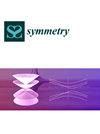Multiplicity Dependence of the Freeze-Out Parameters in Symmetric and Asymmetric Nuclear Collisions at Large Hadron Collider Energies
IF 2.2
3区 综合性期刊
Q2 MULTIDISCIPLINARY SCIENCES
引用次数: 0
Abstract
Strange hadron transverse momentum spectra are analyzed in symmetric pp and PbPb and asymmetric pPb collision systems for their dependence on rapidity and event charged-particle multiplicity. The thermodynamically consistent Tsallis models with and without flow velocity are used to reproduce the experimental data, extracting the freeze-out parameters to gain insights into the underlying physics of the collision processes by looking into the parameters change with different multiplicities, particle types, and collision geometries. We found that with an increase in the event multiplicity, the average transverse flow velocity, effective, and kinetic freezeout temperatures increase, with heavier strange particle species exhibiting a more significant increase. The value of the non-extensivity parameter decreases with an increase in the multiplicity of the particles. For heavier particles, larger Teff and T0 and smaller q have been observed, confirming the quick thermalization and equilibrium for massive particles. Furthermore, the differences in parameter values for particle species are more significant in pp and pPb collisions than in PbPb collisions. In addition, in symmetric pp and PbPb collisions, parameter values (q,T0,βT) show more significant shifts for heavier particles compared to the lighter ones. In contrast, in asymmetric pPb collisions, both heavier and lighter particles display uniform linear progression.大型强子对撞机能量下对称和非对称核碰撞中冻结参数的多重依赖性
分析了对称pp与PbPb和非对称pPb碰撞系统中奇异强子横向动量谱与速度和事件带电粒子多重性的关系。采用具有和不具有流速的热力学一致的Tsallis模型来重现实验数据,提取冻结参数,通过观察参数随不同数量、粒子类型和碰撞几何形状的变化来深入了解碰撞过程的潜在物理特性。结果表明,随着事件数的增加,平均横向流动速度、有效冻结温度和动力学冻结温度均增加,且重的奇异粒子种类增加更显著。非扩张性参数的值随着粒子数量的增加而减小。对于较重的粒子,观察到较大的Teff和T0和较小的q,证实了大质量粒子的快速热化和平衡。此外,pp和pPb碰撞中粒子种类参数值的差异比PbPb碰撞中更显著。此外,在对称的pp和PbPb碰撞中,相对于轻粒子,重粒子的参数值(q,T0,βT)的变化更为显著。相反,在不对称的pPb碰撞中,较重和较轻的粒子都表现出均匀的线性进展。
本文章由计算机程序翻译,如有差异,请以英文原文为准。
求助全文
约1分钟内获得全文
求助全文
来源期刊

Symmetry-Basel
MULTIDISCIPLINARY SCIENCES-
CiteScore
5.40
自引率
11.10%
发文量
2276
审稿时长
14.88 days
期刊介绍:
Symmetry (ISSN 2073-8994), an international and interdisciplinary scientific journal, publishes reviews, regular research papers and short notes. Our aim is to encourage scientists to publish their experimental and theoretical research in as much detail as possible. There is no restriction on the length of the papers. Full experimental and/or methodical details must be provided, so that results can be reproduced.
 求助内容:
求助内容: 应助结果提醒方式:
应助结果提醒方式:


